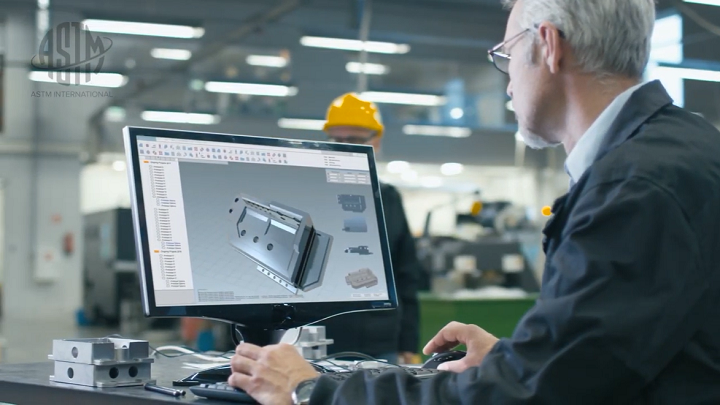ASTM International’s additive manufacturing (AM) technologies committee is developing a new standard that will help with data registration in AM processes to extract and characterize process signatures used to control variations in powder spreading, melt-pool geometry, thermal stability, layer integrity, and more.
The nonprofit standards development organization develops and publishes technical standards for a range of industries, materials, products, services, and systems around the globe. The latest is the proposed creation of a common, open method to collect, process, and organize different AM data types collected by measurement devices used for monitoring laser powder bed fusion (LPBF) processes and inspecting the resulting AM parts.
According to Shaw C. Feng, a member of ASTM International and technical lead for the proposed standard, industrial additive manufacturing users have just begun to understand the importance of multi-sensor, dataset registration in control processes, and qualifying parts.
The standard focuses on functions that monitor and control LPBF processes, predict the material properties of the final part, and qualify other well-known part-quality requirements. All of these functions require registered datasets to be executed accurately. These datasets are generated from a variety of sources, including melt-pool images, scan paths, layer images, and XCT 3D models.
In fact, Feng—an expert in manufacturing metrology and a mechanical engineer in the Life Cycle Engineering Group in the Systems Integration Division of the Engineering Laboratory at the National Institute of Standards and Technology (NIST)— believes industrial additive manufacturers need data registration to extract and characterize process signatures that are used to control variations in powder spreading, melt-pool geometry, thermal stability, layer integrity, and part quality. Among the potential users of this new standard are sensors and software developers, researchers, and AM technology users.
“Registration of these datasets covers metadata, data cleansing, correction, and identification,” explained Feng. “This proposed standard comprises action that users need to take to register those datasets and store them in a repository. In general, each dataset is associated with specific functions in the product life cycle. This standard focuses on two of those functions: build and inspect.”
Datasets associated with the build and inspect functions include, but are not limited to, sensor data, scan commands, photographic images, thermal images, video clips, X-ray computed tomography 2D images and 3D models, CAD models, CMM point clouds, acoustic signals, accelerations, build information, part property data, material microstructural data, mechanical testing data, build data, equipment data, and production management data. More specifically, the data objects that need registration include in-situ photogrammetry and thermography and ex-situ X-ray computed tomography (XCT).
According to Feng, there are three potential impacts of the proposed standard. First, more software tools for data analytics and AM product lifecycle engineering can be used easily. Second, more robust validation and certification processes for aerospace and medical industries will be available. Third, cost savings in data management, curation, and access will increase.
A standard developed to register datasets is expected to speed up usage and AM capabilities, strengthening the technology and facilitating processes for users. The clear benefits of registering data are accessing validated data with known time, locations, and approvals; data alignment and fusion for process monitoring and control; detecting defects traceable to process, material, equipment parameters; AM part qualification, and understanding the AM process for developing predictive models.
According to 3DPrint.com’s own Executive Editor and Vice President of Consulting at SmarTech Analysis, Joris Peels, “Data collection, process monitoring, and control are the very frontier of the industrialization of AM. Universally accepted data standards are needed now to make sure that capture software, management systems, analytics software and machines all speak the same language. For part traceability, especially important in aerospace, data exchange, logging, and capture should be seamless.”
Throughout the last decade, ASTM International has been responsible for creating several AM standards that helped shape the growth and development of the industry. Examples include a standard that offers detailed specifications around what customers should look and ask for when buying an AM part, or a general guide providing requirements and recommendations for using the disruptive technology in product design.
Currently, ASTM’s additive manufacturing committee has invited all interested parties to join in the development of this newly proposed standard and others under development. The global organization thrives on close collaborations that are crucial to ensure that standards and specifications support, and do not limit, the continued growth of emerging industries like AM.
Subscribe to Our Email Newsletter
Stay up-to-date on all the latest news from the 3D printing industry and receive information and offers from third party vendors.
You May Also Like
3D Printing Financials: Fathom Struggles in Financial Quicksand During Critical Transition
Facing a year of key transitions and financial pressures, Fathom (Nasdaq: FTHM) has filed its annual report for 2023 with the U.S. Securities and Exchange Commission (SEC). The document outlines...
Latest Earnings Overview for Australian 3D Printing Firms Titomic and AML3D
Australian 3D printing manufacturing firms Titomic (ASX: TTT) and AML3D (ASX: AL3) reported their financial results for the period from July to December 2023, marking the first half of their...
3D Printing Webinar and Event Roundup: April 7, 2024
Webinars and events in the 3D printing industry are picking back up this week! Sea-Air-Space is coming to Maryland, and SAE International is sponsoring a 3D Systems webinar about 3D...
3D Printing Financials: Unpacking Farsoon and BLT’s 2023 Performance
In the Chinese 3D printing industry, two companies, Farsoon (SHA: 688433) and Bright Laser Technologies, or BLT (SHA: 688333), have recently unveiled their full-year earnings for 2023. Farsoon reported increases...

































